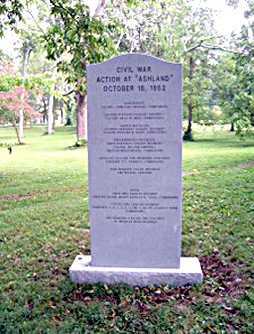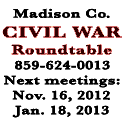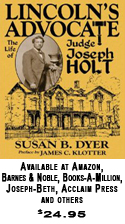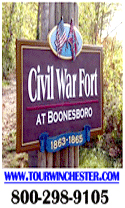|
Even Henry Clay couldn’t have guessed
Civil War would invade his backyard
The Civil War was a conflict filled with ironies and one that did not escape the legacy of Henry Clay, the Great Compromiser who fought so long to prevent secession and keep the union together.
The long-time Kentucky U.S. senator and representative, who died in 1852, was not around to see the war erupt and one of its battles fought in the backyard of his Lexington residence.
On Oct. 8, 1862, Confederate forces failed to win the Battle of Perryville and began to exit the Commonwealth, concluding their invasion of Kentucky. Confederate Gen. John Hunt Morgan refused to let hostilities cease, however, and began attacks to distract the Federals behind Southern lines.
At dawn on Oct. 18, Morgan, having learned of a Union encampment in the woods behind Ashland, Henry Clay’s Lexington estate, attacked some 300 members of the 3rd and 4th Ohio cavalry. Most of the Union soldiers were asleep and Morgan’s 1,800 raiders caught them in a cross fire.
The battle lasted about 15 minutes and resulted in the death of four Union troops with 24 wounded and 290 – including the wounded – taken prisoner.
Confederate casualties are unknown, with the exception of George Washington (Wash) Morgan, John Hunt’s second cousin, who was mortally wounded and died several days later. The Union prisoners were paroled on the steps of Ashland following the skirmish.
According to noted Civil War historian Kent Masterson Brown, Morgan’s Ashland raid was not without humor.
Morgan’s troops crossed the Kentucky River from Madison County and separated into three units. Morgan and his brother-in-law, Col. Basil Duke, went their own way with the smaller unit into Fayette County. Unsure of the best way to enter Lexington, they knocked on the door of a farmer, a Union sympathizer, and asked directions. The farmer offered to lead them. In the darkness, the man didn’t identify them as Confederates.
“All the way to Lexington, this man is bad-mouthing Morgan, saying he ought to be shot, he’s nothing but a horse thief and so-on,” Brown said. “When they near the Ashland estate, Morgan orders his men to attack and the farmer realizes this is not a Union outfit.
“When the farmer asks, ‘Who are you?’ Morgan says, ‘I’m John Hunt Morgan.’”
Brown explains that the man falls out of his saddle and, on his knees, pleads for his life. The whole command breaks into laughter and Morgan frees the farmer who rides away as fast as possible.
|














